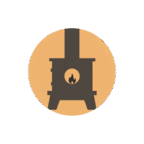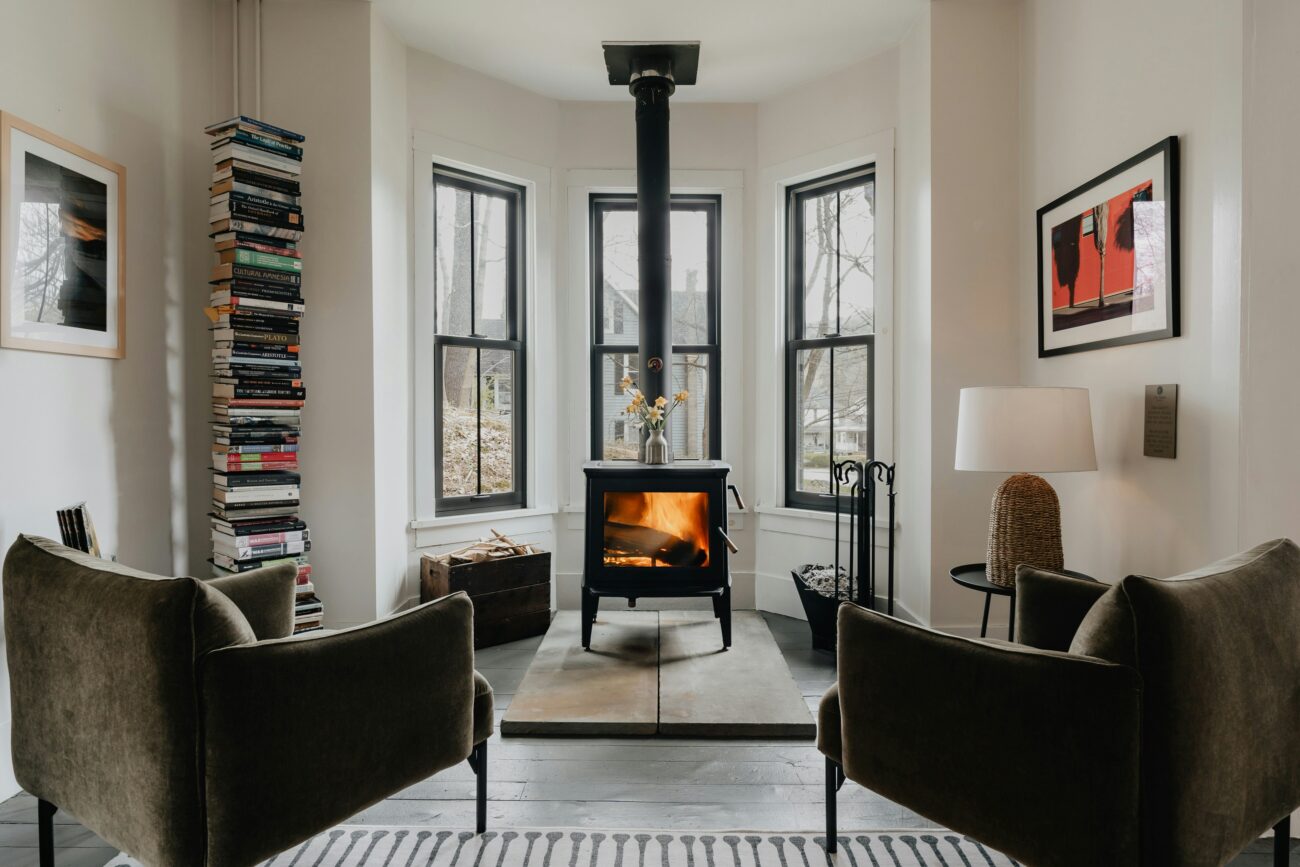After 15 years of maintaining wood stoves in the Pacific Northwest, I’ve learned that proper chimney Learning how to clean wood stove chimney yourself is one of the most important maintenance skills every wood stove owner should master. After 15 years of maintaining wood stoves in the Pacific Northwest, I’ve learned that proper chimney maintenance isn’t just about efficiency—it’s about keeping your family safe. Every winter, I see the same mistakes homeowners make when attempting DIY chimney cleaning, and frankly, some of these errors could be deadly.
Let me share everything I’ve learned about wood stove chimney cleaning, including when you should tackle it yourself and when it’s time to call the professionals.
Why Wood Stove Chimney Cleaning Matters More Than You Think

Your wood stove chimney isn’t just a pipe that carries smoke outside. It’s a critical safety system that, when neglected, becomes a fire hazard. The National Fire Protection Association reports that heating equipment causes over 50,000 house fires annually, with dirty chimneys being a leading culprit.
Here’s what happens when you skip regular cleaning: creosote buildup creates a highly flammable coating inside your chimney. This tar-like substance ignites at relatively low temperatures, potentially causing a chimney fire that can spread to your entire home within minutes.
I’ve witnessed the aftermath of these fires, and trust me—the few hours spent on maintenance aren’t worth the alternative.
Understanding Wood Stove Chimney Cleaning Frequency
The question I hear most often is: “How often should I clean my wood stove chimney?” The answer depends on several factors, but here’s my professional recommendation based on real-world experience.
Standard Cleaning Schedule
Heavy users (burning daily during winter): Every 6-8 weeks during burning season, plus a thorough annual inspection.
Moderate users (3-4 times per week): Every 2-3 months during active use.
Light users (occasional fires): At minimum, once per year before the heating season begins.
Factors That Increase Cleaning Frequency
Certain conditions require more frequent attention:
- Burning unseasoned wood: Wet wood creates significantly more creosote. If your wood hisses when it burns, you’re creating extra buildup.
- Dampered-down burning: Running your stove at low temperatures for extended periods increases creosote formation.
- Exterior chimney placement: Outside chimneys cool faster, causing more condensation and creosote accumulation.
- Older stove models: Pre-EPA certified stoves burn less efficiently, creating more deposits.
I once worked with a family who burned exclusively green pine (despite my warnings). They needed cleaning every three weeks. Don’t be that family.
Regular chimney maintenance also helps you spot other issues early. For instance, if you notice your wood stove glass door becoming cloudy more frequently, it might indicate incomplete combustion that’s also affecting your chimney buildup rate.
Essential Tools and Safety Equipment for DIY Chimney Cleaning

Before attempting to clean your wood stove chimney yourself, you need the right equipment. Cutting corners on tools is like playing Russian roulette with your safety.
Must-Have Safety Gear
Personal protective equipment:
- N95 or P100 respirator mask (creosote dust is toxic)
- Safety goggles with side shields
- Heavy-duty work gloves
- Old clothes you can throw away
- Non-slip boots with good ankle support
Ladder safety essentials:
- Extension ladder rated for your weight plus 50 pounds
- Ladder stabilizer or standoff brackets
- Someone to spot you (never work alone)
- Rope for hauling tools to the roof
Cleaning Tools and Supplies
Chimney cleaning kit:
- Flexible chimney rods (enough to reach your full chimney height)
- Wire chimney brush sized for your flue
- Plastic sheeting and duct tape
- Shop vacuum with HEPA filter
- Flashlight or headlamp
- Drop cloths for interior protection
Professional tip: Buy quality brushes. Cheap brushes lose bristles that can block your damper or create fire hazards. I recommend steel brushes for most applications, though poly brushes work for stainless steel liners.
For those working with small wood stoves for cabins, your cleaning equipment needs may be slightly different due to the compact chimney systems, but the safety principles remain the same.
Step-by-Step Guide: How to Clean Wood Stove Chimney Yourself
Now for the main event. I’ll walk you through the complete process I use when cleaning chimneys, refined through years of experience and a few hard-learned lessons.
Phase 1: Preparation and Safety Setup
Interior preparation takes about 30 minutes but saves hours of cleanup:
Start by removing all decorative items from around your stove. Lay plastic sheeting from wall to wall, covering everything within 10 feet of the stove. Tape the edges securely—creosote dust finds every gap.
Remove the stove’s baffle plates and any removable components you can access. Take photos before disassembly; you’ll thank yourself during reassembly. If you’re dealing with glass door issues during this process, check out our guide on wood stove glass door replacement for proper handling techniques.
Seal the stove opening completely with plastic and tape. Create a small access hole for your cleaning rods, but keep it minimal. Even with careful sealing, some dust will escape.
Exterior ladder setup requires extreme caution:
Position your ladder at a 4:1 angle (for every 4 feet of height, the base should be 1 foot from the wall). Extend it at least 3 feet above the roofline. Never attempt this on windy days or when the roof is wet.
I’ve seen too many accidents from ladder falls. If you’re uncomfortable with heights or your roof has steep angles, call a professional. No amount of money saved is worth a hospital visit.
Phase 2: The Actual Cleaning Process
Starting from the top (which I recommend for most situations):
Remove the chimney cap and spark arrestor. Inspect both for damage while you’re at it. Clean the spark arrestor with a wire brush—clogged screens reduce draft and create backdraft issues.
Connect your first cleaning rod to the brush. Lower it slowly into the chimney, adding sections as needed. The key is controlled movement—aggressive scrubbing can damage clay tiles or chimney liners.
Work in 3-foot sections, moving the brush up and down with firm but gentle pressure. Rotate the rods occasionally to ensure even cleaning. You’ll feel the difference when you hit heavy creosote deposits.
Continue until you reach the damper area. Be extra careful here—damaged dampers are expensive to replace.
Bottom-up cleaning (alternative method):
Some technicians prefer working from below, especially with interior chimneys. Remove the cleanout door or work through the stove opening. The process is similar, but debris falls toward you, making containment more challenging.
Phase 3: Debris Removal and Inspection
Once you’ve completed the brushing, wait 30 minutes for dust to settle before opening your containment system. Remove debris from the smoke shelf area and cleanout door (if accessible).
Use your HEPA vacuum to clean all accessible surfaces. Regular shop vacuums don’t filter fine creosote particles effectively, potentially spreading contamination throughout your home.
Critical inspection points:
Examine the interior chimney walls with a bright flashlight. Look for:
- White staining (efflorescence indicating moisture problems)
- Cracked or missing mortar joints
- Damaged clay tiles or metal liner
- Rust or corrosion on metal components
- Animals or birds nests
Document any issues with photos. These problems won’t improve on their own and typically worsen rapidly.
Recognizing When Professional Help Is Needed
Despite my emphasis on DIY maintenance, some situations require professional intervention. Here’s when to call the experts:
Structural concerns:
- Visible cracks in the chimney exterior
- Loose or missing bricks
- Damaged chimney crown
- Leaning or tilting chimney
Heavy creosote buildup:
- Stage 3 creosote (glazed, shiny appearance)
- Buildup thicker than 1/8 inch
- Tar-like deposits that don’t brush away easily
Safety limitations:
- Multi-story homes requiring complex ladder work
- Steep or damaged roofing
- Physical limitations preventing safe ladder use
- Lack of proper safety equipment
I’ve cleaned chimneys where homeowners attempted to remove heavy creosote with inappropriate tools, causing thousands of dollars in liner damage. Sometimes, professional equipment and expertise are worth the investment.
Common DIY Chimney Cleaning Mistakes to Avoid

Let me share the most frequent errors I encounter, along with their consequences:
Using inappropriate tools: Garden hoses, leaf blowers, or makeshift brushes can damage your chimney lining. I once repaired a chimney where the homeowner used a chain, destroying the clay tiles and requiring a complete reline.
Inadequate containment: Underestimating creosote’s ability to spread leads to contaminated homes. One client spent more on professional cleaning services than a year of professional chimney maintenance would have cost.
Ignoring safety protocols: Working alone, using damaged ladders, or attempting cleaning in poor weather conditions. These shortcuts can result in serious injury or death.
Incomplete cleaning: Focusing only on easily accessible areas while ignoring the smoke shelf, damper, and upper chimney sections. Partial cleaning provides false security while leaving fire hazards intact.
Maintaining Your Chimney Between Professional Cleanings
Proper maintenance extends beyond annual cleaning. Here are the practices I recommend to all my clients:
Monthly during burning season:
- Visual inspection of exterior chimney
- Check for animal activity or nest building
- Verify chimney cap and spark arrestor condition
- Monitor indoor air quality for signs of backdraft
Weekly during heavy use:
- Inspect stove door gaskets and glass
- Check damper operation
- Remove ash buildup (but never store ashes indoors)
- Verify adequate combustion air supply
Daily good practices:
- Burn only seasoned hardwood
- Maintain proper burning temperatures
- Never burn trash, cardboard, or treated lumber
- Ensure adequate air supply for complete combustion
Signs Your Chimney Needs Immediate Attention
Certain warning signs indicate serious problems requiring immediate professional intervention:
Immediate safety concerns:
- White staining on exterior chimney walls
- Rust on damper or firebox components
- Strong odors when not burning
- Animals or birds inside the chimney
- Damaged chimney crown or cap
Performance issues indicating blockage:
- Difficulty starting fires
- Smoke entering your room
- Poor draft or backdraft conditions
- Unusual sounds during operation
Don’t ignore these symptoms. I’ve responded to emergency calls where minor issues became major safety hazards because homeowners delayed addressing warning signs.
Cost Considerations: DIY vs Professional Service

Understanding the financial aspects helps make informed decisions about chimney maintenance:
DIY cleaning costs:
- Initial tool investment: $150-300
- Annual supplies: $50-75
- Time investment: 4-6 hours
- Ongoing equipment maintenance
Professional service costs:
- Basic cleaning: $200-400
- Inspection included: $250-450
- Additional repairs: Variable
- Scheduling convenience and expertise
Consider your comfort level, available time, and long-term costs when deciding. Many homeowners find a hybrid approach works best—annual professional service with mid-season DIY maintenance.
Building a Long-Term Chimney Maintenance Strategy
Successful chimney maintenance requires consistent attention and proper planning. Here’s the approach I recommend:
Develop a maintenance calendar:
- Schedule annual professional inspection
- Plan mid-season cleaning if needed
- Track burning patterns and creosote buildup rates
- Document any changes or concerns
Invest in quality equipment:
- Buy tools once and maintain them properly
- Store equipment in dry, accessible locations
- Replace worn brushes and damaged rods promptly
- Keep safety equipment current and functional
Stay educated:
- Understand your specific stove and chimney requirements
- Learn to recognize developing problems
- Know when to attempt DIY solutions versus calling professionals
- Maintain relationships with qualified service providers
Conclusion: Your Path to Safe, Efficient Wood Stove Operation
Wood stove chimney cleaning isn’t just maintenance—it’s an investment in your family’s safety and your home’s protection. Whether you choose the DIY approach or professional service, consistency is key.
Start with proper education, invest in quality tools, and never compromise on safety. Remember that every chimney is unique, and what works for your neighbor might not be appropriate for your situation.
If you’re unsure about any aspect of the process, don’t hesitate to consult with professionals. A brief consultation costs far less than dealing with fire damage or injury.
Take pride in maintaining your wood stove system properly. There’s satisfaction in understanding your equipment and keeping your family warm and safe throughout the heating season.
Remember: This guide provides general information based on common situations. Always consult local building codes and manufacturer recommendations for your specific installation. When in doubt, contact qualified professionals for assessment and service.


Very Good Information. Thank You!!!!